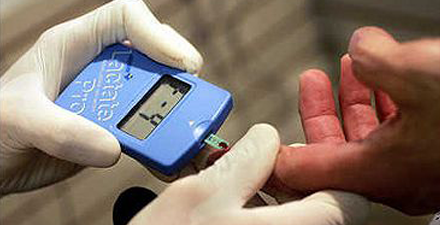
Accurately determining lactate threshold
Accurately determining lactate threshold
A graded exercise test or field test with actual blood lactate sampling is the best way to accurately determine one’s lactate threshold heart rate, pace or work load.
The term “anaerobic threshold” has long been used synonymously with “lactate threshold,” the blood lactate inflection point. The word “anaerobic” is defined as “without air.” This terminology is a source of argument, as the onset of blood lactate accumulation offers no information about anaerobic metabolism and oxygen is present even at maximal exercise intensities (in healthy individuals).
Early models proposed linkages between a lack of oxygen in the working muscle, lactate production and changes in pulmonary ventilation. These causal linkages were attractive to researchers as lactate threshold could be estimated by observing the rate at which the athlete was breathing. Researchers called the point at which pulmonary ventilation and carbon dioxide output begin to increase exponentially “ventilatory threshold,” observable as a substantial increase in breathing rate. Unfortunately, researchers later discovered that factors such as carbohydrate intake, body mass, mode of exercise and speed of movement all can affect ventilatory and lactate threshold determination.
Studies on patients with McArdle’s syndrome place additional doubt on the anaerobic threshold – ventilatory threshold – lactate threshold relationship. McArdle’s syndrome is a disorder where the sufferer lacks the enzyme phosphorylase, rendering them incapable of breaking down glycogen to form lactic acid. Even though McArdle’s syndrome patients are incapable of producing lactic acid, they still demonstrate ventilatory threshold during graded exercise tests. Therefore, it can be assumed that blood lactate levels are not directly linked to breathing rate. In studies using healthy young male subjects, glycogen levels were also found to affect the relationship between lactate threshold and ventilatory threshold. When glycogen was depleted in the subjects, ventilatory threshold occurred at a lower power output than lactate threshold, both occurring lower as compared to test results for well fed subjects. Other studies have also found dissociation of the lactate threshold – ventilatory threshold relationship following an endurance training protocol.
Researchers sought an explanation as to why lactate threshold and ventilatory threshold sometimes occur simultaneously, even though blood lactate accumulation is not necessarily attributed to a lack of oxygen. As exercise intensity increases, fast-twitch muscle fibers are recruited, producing lactic acid regardless of whether or not oxygen is absent. Breathing rate during exercise is predominantly controlled by neural factors, mainly the carotid and aortic bodies, which are sensitive to the amount of oxygen and carbon dioxide present in arterial blood. While these factors may cause lactate threshold and ventilatory threshold to occur simultaneously, it does not necessarily indicate that the working muscles lacked oxygen.
Even though lactate threshold and ventilatory threshold occur simultaneously in some instances, it is still inappropriate to classify their occurrences as an anaerobic threshold. Recruitment of fast-twitch muscle fibers can cause lactate levels to rise regardless or whether or not the muscles are oxygen deficient. Lactate levels rise simply because production and release of lactate occurs at a rate faster than removal mechanisms can accommodate. Even at maximal exercise intensities, when the most oxygen is being utilized (VO2 max), the partial pressure of oxygen in the mitochondria never drops below critical levels. There are simply too many variables affecting ventilatory rate to use it to establish an athlete’s training zones.
Article by Adam Baskin, M.A.
Baskin’s holds a degree in Clinical Exercise Physiology and he is a USA Cycling Elite Coach. He works at the National Training Center in Clermont, Florida, conducting sports science tests including LT, VO2 max and bike fits. Baskin is also a Category 1 rider on the road and track.


